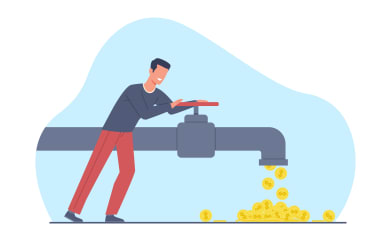A chargeback can be defined as a transaction reversal meant to serve as a form of customer protection from fraudulent activity committed by both merchants and individuals. It can also be described as a demand by a credit card provider for a retailer to make good on the loss of a fraudulent and disputed transaction.
Dealing with a chargeback is a challenging endeavor that a lot of merchants have trouble dealing with. That’s why the best way to avoid having to deal with chargebacks is to prevent them, and ways to do that are to take extra care and be proactive during the transaction process. However, of course, no matter how careful you are, issues will happen, but this step-by-step guide will make sure you understand the procedure so that you’re better equipped to deal with a dispute.
Step 1: A Purchase is Disputed by The Customer
The chargeback process begins when a customer disputes a transaction by contacting their issuer. There are three main reasons why a dispute will be made:
- An ordered item has not been received.
- An ordered item is significantly different from what was described.
- An unauthorized transaction took place.
The cardholder always has the right to dispute a purchase, as all the major card networks guarantee a zero-fraud liability.
Step 2: A Review is Made by The Issuing Bank
The issuing bank will review the transaction that’s been claimed as a dispute and decide whether it should be sent on to the card network. After a review, the bank will determine if the dispute poses an invalid or valid chargeback.
- Invalid chargeback
This is where the transactional data suggests that no fraudulent activity took place, meaning that the issue has been resolved and that the cardholder is notified.
- Valid chargeback
This is where the dispute is considered valid, or at least worthy of further investigation, and the process continues.
Step 3: Customer is Reimbursed
The customer receives immediate credit equal to the disputed amount. The funds will come from the merchants’ commercial bank account and flow into the issuing bank.
Step 4: Chargeback Hand-Offs
The issuing bank will submit the chargeback to the card network once the reimbursement is made. The card network then hands this to the acquirer.
When handing a chargeback to an acquirer, there are usually fees involved, which are ultimately paid by the merchant who conducted the fraudulent activity. During the chargeback process, the acquirer initially covers the processing fees, network fees, and interchange fees, but it’s expected that the merchant reimburses them after the procedure.
Step 5: Chargeback is Received by The Merchant
The merchant will be notified of the dispute, usually by mail or by an account processor online portal; however, they will never be sent the chargeback directly. Instead, the acquirer will receive the issuer’s funds on behalf of the merchant.
When the merchant is informed, the notification will also contain instructions on how to respond and are call to actions for the merchant to gather together compelling evidence in their favor and submit them. The evidence they’re looking for is any data that’s relevant to the chargeback reason code, which categorizes the dispute.
Step 6: The Merchant Responds
At this point, the chargeback is filed and ready to go, and the only thing stopping it from doing so is a response from the merchant. There are cases where no response will be made, for reasons such as:
- They’re unsure what a chargeback is, thus not knowing how to deal with it.
- They may believe that the chargebacks represent lost revenue and that they’re unable to fight it.
- The chargeback represents a minimum transaction value, meaning that it may not be worth their time.
Dealing with a chargeback as a merchant can be challenging to navigate correctly; however, there are third-party companies offering chargeback management solution, who can help merchants get through these issues.
If a merchant fails to respond, the chargeback process ends here, and the card network awards the chargeback to the cardholder, and they retain the previously refunded loss. In contrast, the merchant suffers revenue loss and perhaps acquisition costs too.
However, a merchant can respond with a response letter, which details all their evidence. If this is done, then the next steps are needed.
Step 7: Hand-off of Compiled Evidence
The acquirer receives the evidence and will pass it to the card network, where it will be under review.
Step 8: Issuing Bank Decides
Here, the issuer will review the chargeback claim alongside the merchant’s evidence, and then decide one of two possible outcomes:
- The Merchant Wins
This is where compelling evidence disproves the cardholder’s dispute. This means that the issuing bank will remove the chargeback and that the card network will pull the funds from the issuer and send it to the acquirer, who will then put it back into the merchant’s bank account.
- The Customer Wins
This is where the compelling evidence didn’t do enough to disprove the dispute, meaning that the chargeback is upheld and that the merchant loses funds.
Related Posts
- How to Start a Home Business in New York: Step by Step Guide – Have you always wanted to start your own business but not sure where to begin?…
- How to Start a Bakery in New York: Step by Step Guide – We know you’ve been wanting to open up your own bakery in New York. Our…
- How to Start a Construction Business in New York: Step by Step Guide – There are many steps to starting a construction business in New York. There is a…
- How to Start an Online Business in New York: Step by Step Guide – Are you a New Yorker that has a great idea for an online business but…



